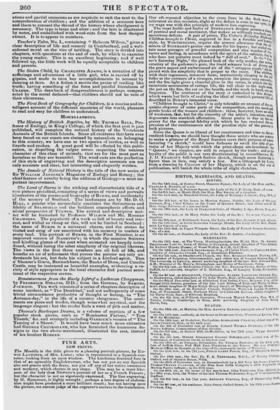FINE ARTS. NEW PRINTS.
The Mantilla is the title given to a pleasing portrait-picture, by ED- WIN LANDSEER, of Mrs. Lister; who is represented in a Spanish cos- tume, looking from an open window. The handsome-featured face is that of an agreeable Englishwoman, who has not put on any Spanish airs and graces with the dress, nor put off any of her native sweetness and modesty, which charms in any shape. This may be a truer like- ness of the lady than NEWTON'S portrait of her as a French Peasant. but the character is not so vigorously expressed. The line engraving, by H. ROBINSON, is highly wrooght : perhaps a less degree of elabora- tion might have produced a more brilliant result ; but not having seen the picture, we cannot judge of the engraver's success in the translation. Our oft-repeated objection to the cross lines in the flesh reiterated on this occasion, slight as the defect is even in oureye,'s:f fwe wage war with this principle of modern line engraving. The most feeble and faulty of STOTHARD'S designs possess a eiltt of poetical and moral sentiment, that makes us willingly overlook monstrous defects. A pair of prints, The Cotter's Saturday Nig. hiC,A Children brought to Christ, engraved in line in a forcible and tot; style, by WORTHINGTON, require the utmost allowance that the M. mirers of STOTHARD'S genius can make for his lapses; but withal tam n some passages of graceful composition and nice touches of ell racter and feeling, in accordance with the spirit of the subjects, ;hull; who does not perceive must indeed be " dull of soul." In theft et ter's Saturday Night," the pleased look of the wily mother, the inet scrutiny of the gudeman's gaze, the timid askance look of Jenny,* the grave aspect and embarrassed air of the " strappan youth,. geed,. picted with the simplicity that is proper to the story. The child
i rak
with their ingenuous, innocent faces, instinctively clinging to ale 4 folks at the entrance of a stranger, complete the group very naturally, and the fire-light gives a cheerful glow to the scene, in which the eh; racteristic accessories of cottage life, the tall chair in the ingle.notik, the pot on the fire, the cat on the hearth, and the work in hand, ere forgotten. The sentiment of the story .s embodied in this design; which wants but little of realizing the ideal of ticottish pastoral life, ag ;
described in BURNS'S immortal verse.
"Children brought to Christ," is only tolerable on account of thee. guisite elegance of some parts of the composition, and the meek azd gentle looks of the women and children : these, however, have an atIcy of weakness, that, but for the sincerity of the artist's intention, would degenerate into mawkish affectation. Great praise is due to theta graver for the congenial fidelity with which he has rendered the er. pression of the countenances and the peculiar style of the paintenn both pictures. Since the Queen is so liberal of her countenance and time to thee. credited limier., we should have thought those artists who are contest to make a glimpse of the Royal features serve their purpose of ma. facturing "a sketch," would have forborne to swell the tide of pot. traits of her Majesty with which the print-shops are inundated: hs; " Queens, " we suppose, are still in request by the trade ; and as the loyalty of the public is not very discriminating in resemblances, Mt, J. D. FRANCIS'S full-length furtive sketch, though more flattering figure than in face, may satisfy a few. But a lithograph by Lim, from a drawing by CHALON of her Majesty, which is on the eve of publication, will banish the whole tribe of slight sketches.


























 Previous page
Previous page